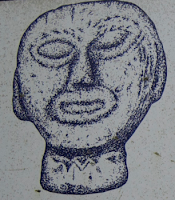Beltany Stone Circle is positioned high on a hilltop in County Donegal with stunning views. It is made up of 64 stones of various sizes enclosing a low earth mound; originally it is thought that there could have been up to 80 stones. The diameter of the circle is around 45m, making it one of the largest stone circles in Ireland. The interior of the site has a number of loose stones strewn around, evidence of disturbance in the past, as noted by archaeologist Oliver Davies in the 1930s. This disturbance probably dates to the nineteenth century or even earlier, as according to the OS Memoir (1836), there had been a cairn or 'vast heap of stones' within the circle, but it had been removed to form fences in the vicinity. Thomas Fagan, who saw the monument in 1846, observed that both the interior and the enclosing circle of stones were 'much disfigured'. He was informed that 'the interior was raised with earth and stones covering and encircling sepulchral graves' and that decayed bones were unearthed here (information from the National Monuments Service, www.archaeology.ie).
So it is certainly possible that this low mound in the centre is the remains of a cairn or large earth mound, and that the stone circle represents the remains of kerbing. It has been suggested that there may have been a megalithic chamber within the circle and that the site is the remains of a passage tomb, though this has not yet been conclusively proven.
Some believe that the stone circle has astronomical alignments, and that it is associated with the pre-Christian festival of Bealtaine (roughly equivalent to May Day). At this festival, it is believed that people gathered together on hilltops to light fires to mark the changing of the seasons. Bealtaine was one of the four major festivals of ancient Ireland and marked the beginning of summer, the other festivals were: Lugnasadh, which was celebrated at the start of August and marked the beginning of Autumn); Samhain (the origin of today’s Halloween) marked the beginning of Winter; and Imbolc which was normally celebrated in early February and marked the beginning of Spring. The name Beltany is clearly derived from Bealtaine and suggests that the site was an important place of congregation and celebration at this important festival.
 A stone head (pictured left) was discovered near the site, though it’s exact provenance is uncertain. It may be prehistoric and its eyes and mouth remind me of those enigmatic figures at Boa Island in County Fermanagh, and like those sculptures it is believed to date to the Iron Age.
A stone head (pictured left) was discovered near the site, though it’s exact provenance is uncertain. It may be prehistoric and its eyes and mouth remind me of those enigmatic figures at Boa Island in County Fermanagh, and like those sculptures it is believed to date to the Iron Age. Beltany Stone Circle is pretty easy to find and is well signposted, it is located in Tops Townland, roughly around a 5 minute drive from Raphoe (around 3 miles south) and about 25 minutes or so from Letterkenny. You’ll find a small carpark at the base of the hill, and a good path leading upwards. I advise wearing decent boots as the site is in a field and ground conditions can be a little rough.
If you have a suggestion for a site I’d love to hear it, please let us know by dropping us a line at info@abartaaudioguides.com or on Facebook, Twitter or Google+, where you can keep up with daily pictures and information about wonderful heritage sites in Ireland.
If you’d like to support us please consider downloading an audioguide from my website www.abartaaudioguides.com. They are designed to be fun and informative whether you are at the site or from the comfort of your own home. Try our audioguide to Viking and Medieval Dublin, available for just €1.99 from www.abartaaudioguides.com
 |
| The path up the hill to Beltany Stone Circle |






